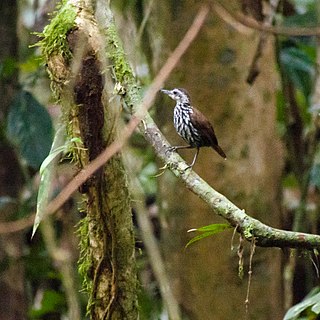
The Brown-headed barbet is an Asian barbet species native to the Indian subcontinent, where it inhabits tropical and subtropical moist broadleaf forests. It is widespread, with its range stretching from the Terai in southern Nepal in the north to Sri Lanka in the south, encompassing most of peninsular India, and listed as Least Concern on the IUCN Red List. It is an arboreal species of gardens and wooded country which eats fruit and insects. It is fairly tolerant of humans and often seen in city parks. It nests in a tree hole, laying 2-4 eggs. It forages on mangoes, ripe jackfruit, papaya, banana, figs and similar cultivated fruit trees. Its habitat includes urban and country gardens; it tends to eschew heavy forest. It nests in a suitable hole in a tree that it will often excavate. Both sexes incubate the eggs and often communicate with each other using their Kura, kura calls.

The yellow-fronted barbet is an Asian barbet, which is an endemic resident breeder in Sri Lanka, where it inhabits subtropical and tropical moist forests, wetlands, plantations and rural gardens up to an altitude of 2,000 m (6,600 ft). It has green plumage with a yellow crown and blue patches below the eyes, on the throat and the chin. It is 21–22 cm (8.3–8.7 in) long and weighs 57–60 g (2.0–2.1 oz). It feeds on berries, fruits and occasionally insects. It nests in a tree hole, where it lays 2-3 eggs.

The mountain wren-babbler is a species of bird in the family Pellorneidae. It is native to the Iran Mountains of northeastern Borneo. Its natural habitats are subtropical or tropical moist lowland forest and subtropical or tropical moist montane forest.

The Malayan black magpie is a species of bird in the family Corvidae. Despite its name, it is neither a magpie nor, as was long believed, a jay, but a treepie. Treepies are a distinct group of corvids externally similar to magpies.

The yellow-rumped flowerpecker is a species of bird in the family Dicaeidae. It is found in Brunei, Indonesia, and Malaysia on the island of Borneo, to which it is endemic. Its natural habitats are subtropical or tropical moist lowland forests and subtropical or tropical moist montane forests.

The Bornean wren-babbler is a species of bird in the family Pellorneidae. It is found in Brunei, Indonesia, and Malaysia, where it is endemic to the island of Borneo. Its natural habitats are subtropical or tropical moist lowland forest and subtropical or tropical swampland. It is threatened by habitat loss.

Everett's thrush is a species of bird in the family Turdidae. The name commemorates British colonial administrator and zoological collector Alfred Hart Everett.

The flame-fronted barbet is an Asian barbet native to Java and Bali. It has a green plumage, a yellow-orange forehead, a blue nape, and an orange crescent on the chest. It is about 19.5–23 cm (7.7–9.1 in) long and weighs 61–79 g (2.2–2.8 oz). Its natural habitats are subtropical or tropical moist lowland forest and subtropical or tropical moist montane forest.

The golden-whiskered barbet is an Asian barbet species native to the western Malay Archipelago, where it inhabits foremost forests up to 1,500 m (4,900 ft) elevation. It has been listed as Least Concern on the IUCN Red List since 2004 because of its wide distribution.

The brown-throated barbet is a species of bird in the family Megalaimidae. It is endemic to western Java.

The Bornean barbet is a species of bird in the Megalaimidae family. It is found in Indonesia and Malaysia where it is endemic to the island of Borneo. Its natural habitats are subtropical or tropical moist lowland forests and subtropical or tropical moist montane forests.

The yellow-crowned barbet is a species of bird in the Megalaimidae family. It is found in Brunei, Indonesia, Malaysia, Singapore, and Thailand. Its natural habitats are subtropical or tropical moist lowland forests and subtropical or tropical swamps. It is threatened by habitat loss.

The black-banded barbet is a bird species in the Megalaimidae family. It is endemic to Java and Bali.

The red-vented barbet is an Asian barbet native to Laos, Vietnam and Cambodia, where it inhabits subtropical or tropical moist lowland forest and subtropical or tropical moist montane forests.

The red-throated barbet is a species of bird in the family Megalaimidae. It is found in Brunei, Indonesia, Malaysia, Myanmar, Singapore, and Thailand. Its natural habitats are subtropical or tropical moist lowland forest and subtropical or tropical swamps. It is threatened by habitat loss.

The golden-naped barbet is a member of the family Megalaimidae. It is found in Indonesia and Malaysia, where it is endemic to the island of Borneo. Its natural habitats are subtropical or tropical moist lowland forest and subtropical or tropical moist montane forest.

The red-crowned barbet is a species of bird in the family Megalaimidae. It is found in Brunei, Indonesia, Malaysia, Myanmar, Singapore, and Thailand. Its natural habitats are subtropical or tropical moist lowland forests and plantations. It is threatened by habitat loss.

The fire-tufted barbet is a species of bird in the Asian barbet family Megalaimidae. It is native to Peninsular Malaysia and Sumatra, where it inhabits tropical moist lowland and montane forests. It has been listed as Least Concern on the IUCN Red List since 2004. Its scientific name was proposed by Salomon Müller in 1836, who described a barbet from Sumatra.

The Chinese barbet is a bird in the family Megalaimidae. The species was first described by Robert Swinhoe in 1870. It is endemic to southern China.
The necklaced barbet is an Asian barbet species occurring in Laos and southern Vietnam, where it inhabits subtropical, lowland tropical moist forests and montane forests up to an altitude of 2,700 m (8,900 ft).



















